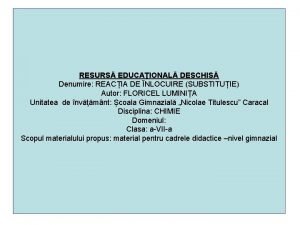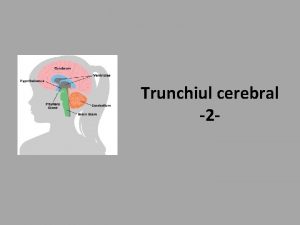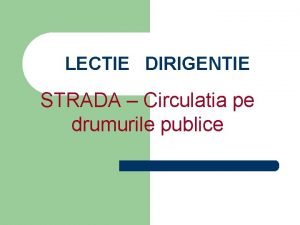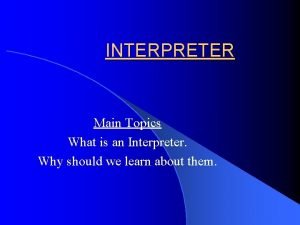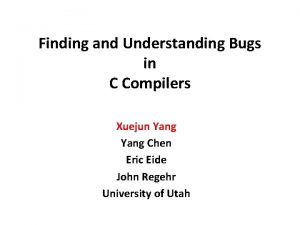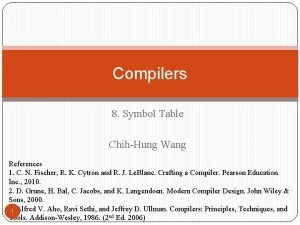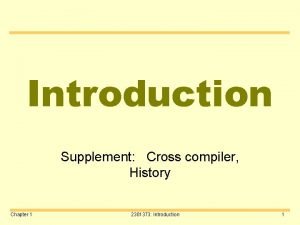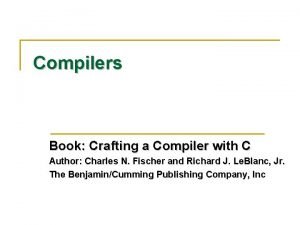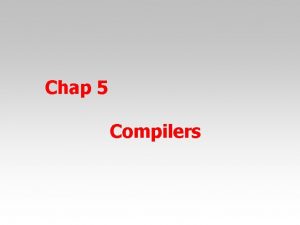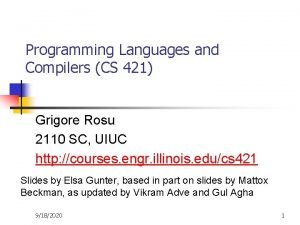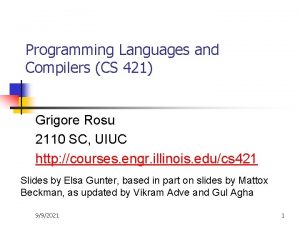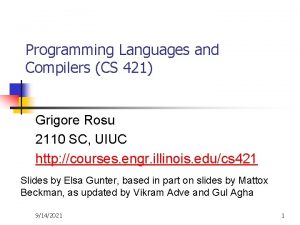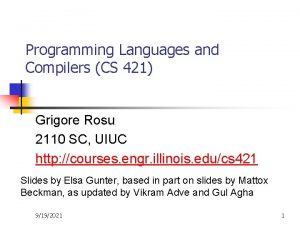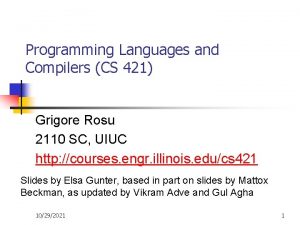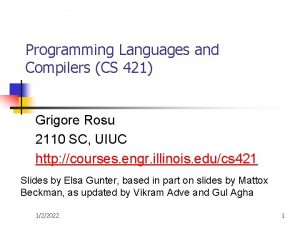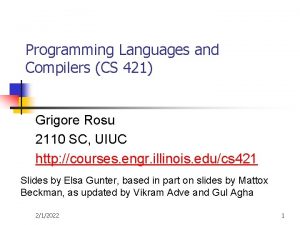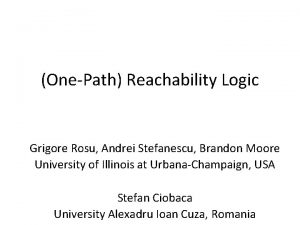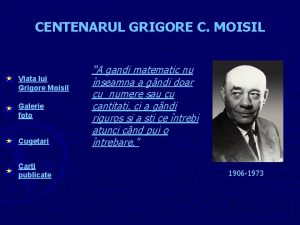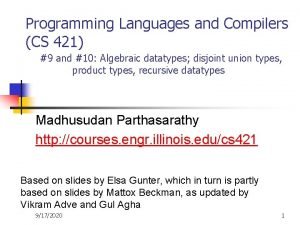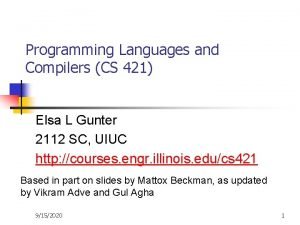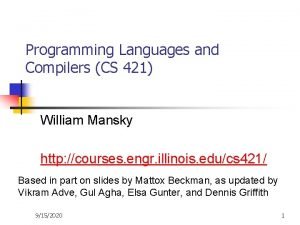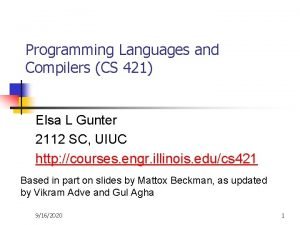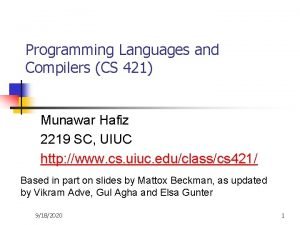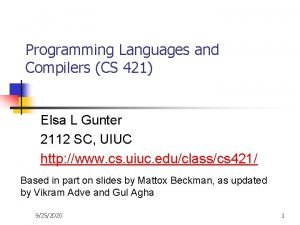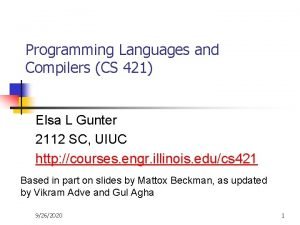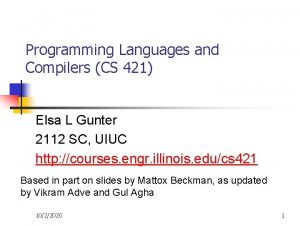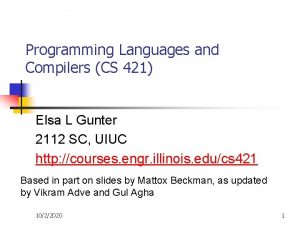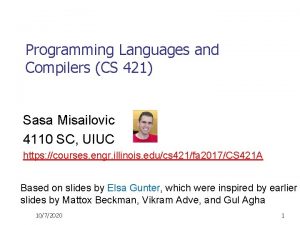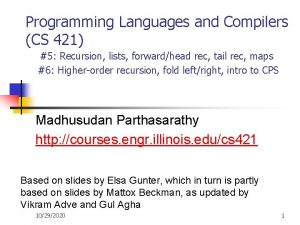Programming Languages and Compilers CS 421 Grigore Rosu



























![Call-by-value (Eager Evaluation) (let I = V in E, m) --> (E[V/ I ], Call-by-value (Eager Evaluation) (let I = V in E, m) --> (E[V/ I ],](https://slidetodoc.com/presentation_image_h2/b91e2424a6eb2fe66a25312964a5a806/image-28.jpg)



- Slides: 31

Programming Languages and Compilers (CS 421) Grigore Rosu 2110 SC, UIUC http: //courses. engr. illinois. edu/cs 421 Slides by Elsa Gunter, based in part on slides by Mattox Beckman, as updated by Vikram Adve and Gul Agha 9/20/2021 1

Interpreter n Takes abstract syntax trees as input n n One procedure for each syntactic category (nonterminal) n n n In simple cases could be just strings eg one for expressions, another for commands If Natural semantics used, tells how to compute final value from code If Transition semantics used, tells how to compute next “state” n To get final value, put in a loop 9/20/2021 2

Natural Semantics Example n n compute_exp (Var(v), m) = look_up v m compute_exp (Int(n), _) = Num (n) … compute_com(If. Exp(b, c 1, c 2), m) = if compute_exp (b, m) = Bool(true) then compute_com (c 1, m) else compute_com (c 2, m) 9/20/2021 3

Natural Semantics Example n n n compute_com(While(b, c), m) = if compute_exp (b, m) = Bool(false) then m else compute_com (While(b, c), compute_com(c, m)) May fail to terminate - exceed stack limits Returns no useful information then 9/20/2021 4

Transition Semantics n n n Form of operational semantics Describes how each program construct transforms machine state by transitions Rules look like (C, m) --> (C’, m’) or (C, m) --> m’ C, C’ is code remaining to be executed m, m’ represent the state/store/memory/environment n Partial mapping from identifiers to values n Sometimes m (or C) not needed Indicates exactly one step of computation 9/20/2021 5

Expressions and Values n n C, C’ used for commands; E, E’ for expressions; U, V for values Special class of expressions designated as values n n Eg 2, 3 are values, but 2+3 is only an expression Memory only holds values n 9/20/2021 Other possibilities exist 6

Evaluation Semantics n n n Transitions successfully stops when E/C is a value/memory Evaluation fails if no transition possible, but not at value/memory Value/memory is the final meaning of original expression/command (in the given state) Coarse semantics: final value / memory More fine grained: whole transition sequence 9/20/2021 7

Simple Imperative Programming Language n n n I Identifiers N Numerals B : : = true | false | B & B | B or B | not B | E <E|E=E E: : = N | I | E + E | E * E | E - E | - E C: : = skip | C; C | I : = E | if B then C else C fi | while B do C od 9/20/2021 8

Transitions for Expressions n Numerals are values n Boolean values = {true, false} n Identifiers: (I, m) --> (m(I), m) 9/20/2021 9

Boolean Operations: Operators: (short-circuit) (false & B, m) --> (false, m) (B, m) --> (B”, m) (true & B, m) --> (B, m) (B & B’, m) --> (B” & B’, m) n (true or B, m) --> (true, m) (B, m) --> (B”, m) (false or B, m) --> (B, m) (B or B’, m) --> (B” or B’, m) (not true, m) --> (false, m) (not false, m) --> (true, m) 9/20/2021 (B, m) --> (B’, m) (not B, m) --> (not B’, m) 10

Relations (E, m) --> (E’’, m) (E ~ E’, m) --> (E’’~E’, m) (E, m) --> (E’, m) (V ~ E, m) --> (V~E’, m) (U ~ V, m) --> (true, m) or (false, m) depending on whether U ~ V holds or not 9/20/2021 11

Arithmetic Expressions (E, m) --> (E’’, m) (E op E’, m) --> (E’’ op E’, m) (E, m) --> (E’, m) (V op E, m) --> (V op E’, m) (U op V, m) --> (N, m) where N is the specified value for U op V 9/20/2021 12

Commands - in English n n n skip means done evaluating When evaluating an assignment, evaluate the expression first If the expression being assigned is already a value, update the memory with the new value for the identifier When evaluating a sequence, work on the first command in the sequence first If the first command evaluates to a new memory (ie completes), evaluate remainder with new memory 9/20/2021 13


If Then Else Command - in English If the boolean guard in an if_then_else is true, then evaluate the first branch n If it is false, evaluate the second branch n If the boolean guard is not a value, then start by evaluating it first. n 9/20/2021 15

If Then Else Command (if true then C else C’ fi, m) --> (C, m) (if false then C else C’ fi, m) --> (C’, m) (B, m) --> (B’, m) (if B then C else C’ fi, m) --> (if B’ then C else C’ fi, m) 9/20/2021 16

While Command (while B do C od, m) --> (if B then C; while B do C od else skip fi, m) In English: Expand a While into a test of the boolean guard, with the true case being to do the body and then try the while loop again, and the false case being to stop. 9/20/2021 17

Example Evaluation n First step: (if x > 5 then y: = 2 + 3 else y: =3 + 4 fi, {x -> 7}) --> ? 9/20/2021 18

Example Evaluation n First step: (x > 5, {x -> 7}) --> ? (if x > 5 then y: = 2 + 3 else y: =3 + 4 fi, {x -> 7}) --> ? 9/20/2021 19

Example Evaluation n First step: (x, {x -> 7}) --> (7, {x -> 7}) (x > 5, {x -> 7}) --> ? (if x > 5 then y: = 2 + 3 else y: =3 + 4 fi, {x -> 7}) --> ? 9/20/2021 20

Example Evaluation n First step: (x, {x -> 7}) --> (7, {x -> 7}) (x > 5, {x -> 7}) --> (7 > 5, {x -> 7}) (if x > 5 then y: = 2 + 3 else y: =3 + 4 fi, {x -> 7}) --> ? 9/20/2021 21

Example Evaluation n First step: (x, {x -> 7}) --> (7, {x -> 7}) (x > 5, {x -> 7}) --> (7 > 5, {x -> 7}) (if x > 5 then y: = 2 + 3 else y: =3 + 4 fi, {x -> 7}) --> (if 7 > 5 then y: =2 + 3 else y: =3 + 4 fi, {x -> 7}) 9/20/2021 22

Example Evaluation Second Step: (7 > 5, {x -> 7}) --> (true, {x -> 7}) (if 7 > 5 then y: =2 + 3 else y: =3 + 4 fi, {x -> 7}) --> (if true then y: =2 + 3 else y: =3 + 4 fi, {x -> 7}) n Third Step: (if true then y: =2 + 3 else y: =3 + 4 fi, {x -> 7}) -->(y: =2+3, {x->7}) n 9/20/2021 23

Example Evaluation n • Fourth Step: (2+3, {x-> 7}) --> (5, {x -> 7}) (y: =2+3, {x->7}) --> (y: =5, {x->7}) Fifth Step: (y: =5, {x->7}) --> {y -> 5, x -> 7} 9/20/2021 24

Example Evaluation Bottom Line: (if x > 5 then y: = 2 + 3 else y: =3 + 4 fi, {x -> 7}) --> (if 7 > 5 then y: =2 + 3 else y: =3 + 4 fi, {x -> 7}) -->(if true then y: =2 + 3 else y: =3 + 4 fi, {x -> 7}) -->(y: =2+3, {x->7}) --> (y: =5, {x->7}) --> {y -> 5, x -> 7} • 9/20/2021 25

Transition Semantics Evaluation n A sequence of steps with trees of justification for each step (C 1, m 1) --> (C 2, m 2) --> (C 3, m 3) --> … --> m n n Let -->* be the transitive closure of --> Ie, the smallest transitive relation containing --> 9/20/2021 26

Adding Local Declarations n n n Add to expressions: E : : = … | let I = E in E’ | fun I -> E | E E’ fun I -> E is a value Could handle local binding using state, but have assumption that evaluating expressions doesn’t alter the environment We will use substitution here instead Notation: E [E’ / I ] means replace all free occurrence of I by E’ in E 9/20/2021 27
![Callbyvalue Eager Evaluation let I V in E m EV I Call-by-value (Eager Evaluation) (let I = V in E, m) --> (E[V/ I ],](https://slidetodoc.com/presentation_image_h2/b91e2424a6eb2fe66a25312964a5a806/image-28.jpg)
Call-by-value (Eager Evaluation) (let I = V in E, m) --> (E[V/ I ], m) (E, m) --> (E’’, m) (let I = E in E’, m) --> (let I = E’’ in E’) ((fun I -> E) V, m) --> (E[V / I ], m) (E’, m) --> (E’’, m) ((fun I -> E) E’, m) --> ((fun I -> E) E’’, m) 9/20/2021 28

Call-by-name (Lazy Evaluation) n (let I = E in E’, m) --> (E’ [E / I ], m) n ((fun I -> E’ ) E, m) --> (E’ [E / I ], m) Question: Does it make a difference? n It can depending on the language n 9/20/2021 29

Church-Rosser Property n n n Church-Rosser Property: If E-->* E 1 and E-->* E 2, if there exists a value V such that E 1 -->* V, then E 2 -->* V Also called confluence or diamond property Example: E= 2 + 3 + 4 E 1 = 5 + 4 E 2= 2 + 7 V =9 9/20/2021 30

Does It always Hold? n n n No. Languages with side-effects tend not be Church -Rosser with the combination of call-by-name and call-by-value Alonzo Church and Barkley Rosser proved in 1936 the -calculus does have it Benefit of Church-Rosser: can check equality of terms by evaluating them (Given evaluation strategy might not terminate, though) 9/20/2021 31
 Cs 421
Cs 421 Cs 421 uiuc
Cs 421 uiuc Grigore rosu
Grigore rosu Fisa de lucru reactia de substitutie
Fisa de lucru reactia de substitutie Castelul arcalia
Castelul arcalia Nuclei somatomotori
Nuclei somatomotori Muntele rosu rhododendron
Muntele rosu rhododendron Trecerea pe rosu la semafor
Trecerea pe rosu la semafor Simbolul martisorului alb si rosu
Simbolul martisorului alb si rosu What is an interpreter
What is an interpreter Finding and understanding bugs in c compilers
Finding and understanding bugs in c compilers Lex leblanc
Lex leblanc Compiler
Compiler Real-time systems and programming languages
Real-time systems and programming languages Advantages of high level language
Advantages of high level language Real-time systems and programming languages
Real-time systems and programming languages Binarymove c++
Binarymove c++ Cousins of compiler
Cousins of compiler Crafting a compiler
Crafting a compiler Basic compiler functions
Basic compiler functions Front and back end of compiler
Front and back end of compiler Multithreaded programming languages
Multithreaded programming languages Cxc it
Cxc it Introduction to programming languages
Introduction to programming languages Plc programming languages
Plc programming languages Procedural programming languages
Procedural programming languages Comparative programming languages
Comparative programming languages Alternative programming languages
Alternative programming languages Strongly typed vs weakly typed
Strongly typed vs weakly typed Transmission programming languages
Transmission programming languages Adam doupe cse 340
Adam doupe cse 340 Integral data type in c
Integral data type in c



